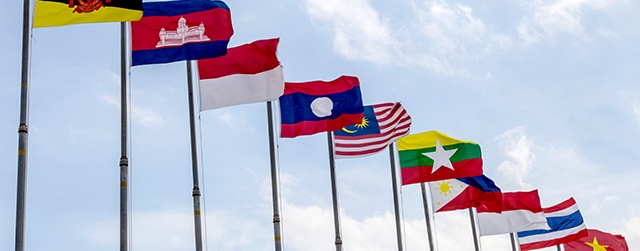Banks in Southeast Asia confront integration and fintech amidst explosive growth. Could it be too much, too fast?

Explosive economic growth has pushed the banking industry in Southeast Asia into its own rapid growth phase, fueled by an expanding population that can afford bank services, regional integration, and adoption of new, fintech-driven business processes. Operating performance, asset and credit quality, and access to competitive funding have all been trending upward in 2018, while solid loan growth has helped boost core earnings and profitability.
Demographics underpin the growth dynamic. The McKinsey Global Institute estimates that by 2030, the number of households in the consuming class in the 10-country Association of Southeast Asian Nations will more than double to 163 million from the current 81 million. The ASEAN group is home to over 630 million people and around half this population is under 30 years of age.
Potential customers abound, given that a large proportion of the population have no banking relationship—estimated by the World Bank at around 80% in Indonesia, the Philippines, and Vietnam and 30% in Malaysia and Thailand. However, this underscores a sharp divide within ASEAN. In Indonesia, Malaysia, the Philippines, Singapore, and Thailand—the so-called “ASEAN 5”—the banking industry is well established
and relatively sophisticated, while in most of the countries that make up the BCMLV group—Brunei, Cambodia, Myanmar, Laos, and Vietnam—banking is profoundly underdeveloped (Brunei being an exception).
Integrating the banking industry across these two groupings is a massive challenge given the vastly divergent levels of economic development and the complexities of melding financial regulation into a one-size-fits-all template. But this is what the 10 nations are attempting with the ASEAN Banking Integration Framework (ABIF). Endorsed by the association’s central banks in 2014 and scheduled to be implemented over the next two years, ABIF allows banks meeting certain criteria to have greater access to other ASEAN markets and more flexibility operating there. At the same time, member states have committed to creating stronger regulatory and supervisory cooperation arrangements to mitigate the risks of financial contagion.
Full realization of ABIF is likely to lead to regional banking consolidation and heightened competition in such areas as cash management, hedging products, trade finance, foreign exchange, wealth management, and banking services. Funding access will become easier, especially for small and medium-sized enterprises, which will be able to draw on a larger pool of savings and deeper capital markets.
“A major focus for public policymakers across the ASEAN region now is the opportunity for interoperable payments capabilities to avoid a country-by-country patchwork of new payment products,” says Zarawski.
Meeting Fintech’s Challenge
ASEAN banks face increasing challenges from non-banks. Digital banks enjoy some advantages over physical banks, such as lower staff costs, and can pass through these savings in lower loan and mortgage rates and higher interest rates on savings.
The shift is already underway. Following the successful introduction of digital-only banks in Europe, Singapore’s DBS Group opened India’s first online-only bank in 2016—now with more than 2 million customers—and Malaysia’s CIMB Group Holdings launched a fully digital bank in March to serve customers in Vietnam and the Philippines.
ASEAN digital-banking penetration has grown dramatically. Singapore is the clear leader in customers accessing bank accounts via the internet: more than 90%; it’s around 40% in Indonesia, Malaysia, and Vietnam; and 20% in the Philippines and Thailand, according to McKinsey. Investment in ASEAN fintech has ballooned from around US$14 million in 2012 to some US$338 million in 2017, according to a report from Singapore’s United Overseas Bank. Brands such as Alipay, Lufax, and Wepay are radically altering the banking landscape within ASEAN.
“ASEAN countries are investing in payments systems and infrastructure at a considerably higher rate than the global average,” notes Lu Zarawski, practice lead for retail banking at ACI Worldwide. “The success of Alipay and Wepay has unleashed the potential for ’QR Code Contagion,’ wherein consumers and business across the region expect QR codes.”
New national payment infrastructures like Singapore’s G3 FAST and Malaysia’s Paynet, which allow users to make immediate payments based on payee details like mobile phone numbers, national ID card numbers, and business IDs, are transforming the transaction landscape. Accenture estimates that in Singapore, traditional-bank revenues will fall 33% by 2025 due to fintech. But increasingly in the region, banks are investing in fintech enterprises.
Besides offering cashless payment services, fintechs are invading other areas, such as real estate lending and wealth management. Venky Srinivasan, group vice president at Oracle’s Financial Services Global Business Unit notes that Thailand, for example, is taking up blockchain-based smart contracts.
ASEAN banks are also moving quickly to adopt digital technology in areas such as mobile banking, robotic process automation, chatbots, peer-to-peer funding, data analytics, cloud computing, contactless ATM, and social media engagement. These micro elements are playing out most rapidly in the ASEAN Five, while in the BCMLV subgroup, banking penetration rates and smartphone use haven’t yet gained critical mass. However, it’s in the BCMLVs that fintech may have the most profound impact.
Indonesia, with a large population of widely dispersed poor, has struggled with financial inclusion. “Fintechs are now leapfrogging this problem with solutions such as mobile cash and mobile-based lending,” says Srinivasan. In the Philippines, one fintech is experimenting with social media-based scoring for SME lending. “This is truly plugging the innovation gap that banks will always find difficult to fill,” he adds.
In countries like Indonesia and Thailand, “we expect to see the launch of digital-only fintech banks that are able to service young customers completely digitally,” says Srinivasan. “In even less developed economies, like Myanmar, fintechs are setting up mobile-payments infrastructure, and so are banks.”
“The opportunity right now, and many years into the future,” he continues, “is large enough for more banks and fintechs alike.”
Private-Sector Leverage
More broadly, progress toward a tech-powered, regionally integrated banking system that serves a far larger proportion of the population is playing out in an environment with several potential headwinds. Currencies in ASEAN countries that are running current account deficits could come under pressure, increasing the risk of a significant increase in non-performing loans and a knock-on effect on banks’ balance sheets and ability to extend credit.
“The ASEAN region is quite diverse but one common risk across the different banking systems is the high level of private sector leverage, and the distribution of leverage towards borrowers that are vulnerable to higher interest rates,” notes Eugene Tarzimanov, senior credit officer in Moody’s Financial Institutions Group in Hong Kong. “While the debt buildup has slowed in many markets since 2015, private-sector debt levels relative to GDP are still materially higher than they were 10 years ago.”
Pressure on costs may emerge from the application of the International Accounting Standards Board’s IFRS 9 rules for financial instruments, which took effect at the start of the year. The accounting change is likely to produce more volatility in banks’ income statements. Fitch Ratings estimates that 75% of ASEAN banks will experience a deterioration in their common Tier 1 ratios as a result, although it projects a decline of only around 50 basis points for banks in the ASEAN Five. Not so lucky would be the nascent banking industries in the BCLMV.
ASEAN banks are on an ambitious course to integrate, adopt fintech, and extend banking services to the region’s emerging markets. How quickly they get there will depend in part on how well they address these challenges—if and when they come.



